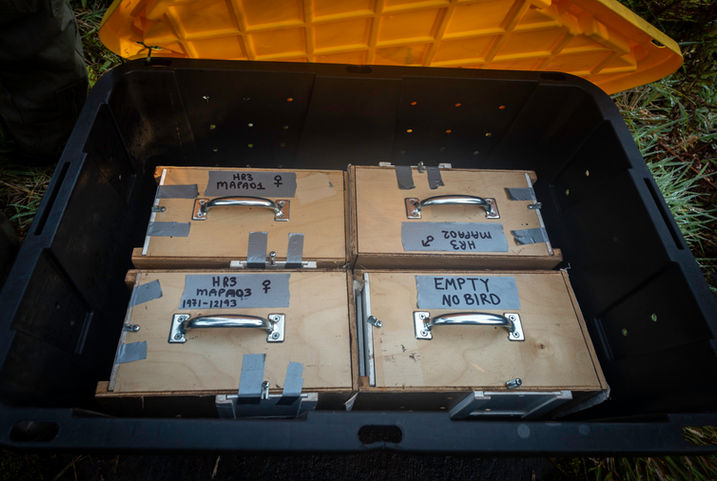Conservation at 6,000 feet
The introduction of mosquitoes to Hawaii has lead to the extinction of dozens of unique colorful songbirds found nowhere else on earth. Many of the remaining species, called Hawaiian honeycreepers, have found refuge from mosquito-borne disease on the slopes of Maui's Haleakalā volcano. But as climate change warms Maui, mosquitoes are penetrating elevations previously inaccessible to them. To combat the rapidly increasing threat of disease, biologists are catching the last wild honeycreepers to safeguard them in captivity. Simultaneously, biologists are suppressing the mosquito population and restoring habitat. Once the threat of disease has been neutralized, the captured birds will be released back into the wild.
Published in BBC Wildlife Magazine December 2024

Conservation at 6,000 feet
Following the introduction of mosquitoes to Hawaii, native honeycreepers, a group of small, colorful birds, have found refuge from mosquito-borne disease on the slopes of Haleakala volcano. As climate change warms Maui, however, mosquitoes are penetrating elevations previously inaccessible to them. To combat the rapidly increasing threat of disease, biologists are catching the last birds to safeguard them in captivity. Simultaneously, biologists are releasing suppressing the mosquito population and restoring habitat. Once the threat of disease has been neutralized, they will release the birds back into the wild.
Published in BBC Wildlife Magazine December 2024
Bathing Frogs
Batrachochytrium dendrobatidis, also called the chytrid fungus, is responsible for the decline or extinction of hundreds of amphibian species around the world. Chytrid infects permeable amphibian skin, disrupting the essential flow of water and electrolytes and often leading to death.
In a bid to save diseased amphibians, biologists from the Forest Service, universities, and private timber companies are collaborating to treat wild frogs with antifungal medications. In northern California, hundreds of thumbnail-sized Cascades frogs are bathed every day for a week in an antifungal slurry. These treatments will give the young frogs time to outgrow their sensitivity to the fungus and improve their chances of reaching adulthood. Recent research suggests that antifungal treatments can reverse population declines for imperiled amphibians.
Published in National Wildlife Magazine

Saving the Copperbelly
When an endangered species becomes so imperiled that extinction seems imminent, scientists may have no choice but to collect the last wild individuals and create a captive breeding program. Condors in California, red wolves in North Carolina, and black-footed ferrets in Colorado have all been saved from extinction through captive propagation. In the rural expanse of cropland and turf grass that covers the intersection between Ohio, Michigan, and Indiana, an endangered subspecies of watersnake will soon receive this same treatment—that is, if any still exist. Despite intensive surveys to relocate them, a live copper-bellied watersnake had not been seen since in years. In a bid to save the copperbelly, the US Fish and Wildlife Service is partnering with the Toledo Zoo to find and capture any remaining copperbellies to foster the next generation. But can a last ditch captive breeding program save the midwest’s rarest snake in time?
Published in The Gaurdian

Animal Products
A woman dressed for Halloween holds a dried bat, offered as a seasonal trinket at an oddity-themed gift shop in Portland, Oregon. While retailers often claim these specimens are ethically sourced, bat researchers argue otherwise. Bats reproduce too slowly for captive breeding to be commercially viable, suggesting most dried bats come from the wild. In nature, bat carcasses are rapidly broken down by insects and scavengers, making the sourcing of these specimens suspect. To satisfy growing demand for Halloween décor, thousands of bats are killed and imported annually into the U.S. from Southeast Asia and Indonesia. The impact on wild populations remains unclear, but studies reveal troubling trends: up to 30% of bats sold are mislabeled, with some belonging to protected or declining species. Online platforms like eBay and Etsy have been caught selling endangered species. Improperly prepared dried bats pose another risk by potentially harboring diseases such as rabies, Ebola, or coronaviruses, which could infect unwitting buyers. This macabre trade highlights the urgent need for better regulation and public awareness of the ecological and public health implications.
In this series, I explore the world of animal products.




































